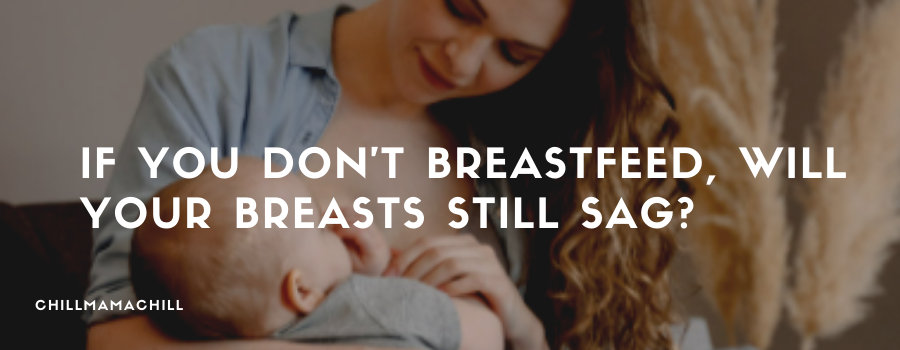In the course of your lifetime, your body will undergo numerous changes. One that you may question a lot is sagging boobs after delivering your baby, whether you’re nursing or not. So, if you don’t breastfeed, will your breasts still sag?
A naturally occurring phenomenon, breast ptosis is the scientific term referring to drooping breast tissue. Cooper’s ligament or suspensory ligament is the connective tissue that helps connect your boobs to surrounding chest muscles, maintaining structural integrity. Made of elastin and collagen, it’s the main reason for saggy breasts.
In this era of body positivity, sagging breasts can cause insecurity and more than a little embarrassment. One misconception is that you can prevent your breast from sagging by not breastfeeding, which is not true.
In this article, learn what causes your boobs to droop, the effects of nursing and how you can minimize that.
Is There A Relationship between Breast Sagging and Pregnancy?
Breasts are ligament and fatty tissue, lacking muscles to strengthen their structure. Sagging is one of the most natural changes you’ll experience, especially as you age. Pregnancy and childbearing take much of the blame, seeing as breasts grow larger, after which they fill up with milk. That happens whether you carry the baby to full term, breastfeed or not, as your breasts will appear fuller, shrink or sag.
If you choose not to breastfeed after delivery, you’ll have breast engorgement with possible leakage for up to ten days. Since milk is produced on a supply and demand basis, your production will dry up without stimulation, and your boobs will shrink. Without nursing, pumping, or expressing, your body starts to secret the inhibiting hormone prolactin, which causes milk production to shut down.

Your cup size may become smaller than before you got pregnant as milk-producing ducts get eaten by alveoli. There’ll be less tissue, replaced by fat, resulting in their looking deflated, and the larger they are, the saggier they’ll appear.
While age is a major cause for breast sagging, there isn’t a specific stage when boobs are expected to sag. Your breasts can begin to droop in your early twenties, while a woman in their late forties will still have a perky pair. It’s due to the causative dynamics such as genetics, body mass index, exercise without support, weight gain and loss, plus childbirth or abortion that determine when the sag will set in.
What Are the Typical Reasons for Breasts to Sag?
It’s pregnancy, rather than breastfeeding, that causes your breasts to sag. There’s also a connection between the number of times you are pregnant and how sagged your boobs are. A history of tobacco smoking, which negatively affects the elastin protein in your skin, contributes to breast sagginess. The breakdown is attributed to carcinogens in cigarette smoke.
Other factors that cause breast sagging include;
Genetics
Your skin type, elasticity, stretch marks, and breast size are a matter of genetics. If your cup size is large and your skin is predisposed to stretching, your boobs will likely sag from gravity and the stretchiness of your ligaments.
Aging
Age brings on skin elasticity, and your breasts are more likely to sag from 35 years onwards than before.
Gravity
When your breasts are large, gravitational pull takes a toll on them. A well-fitted but also comfortable bra is helpful to support large boobs as they grow.
Body Mass Index
A high body mass index or BMI causes weight fluctuations that cause unnecessary breast stretching. You can avoid this by maintaining a healthy weight, which arrests the progression of sagging.
Menopause
Once you reach menopausal age, there’s a drop in your estrogen hormone. That causes tissue collagen to decrease, which results in wrinkles, and sagging breasts.
How Can I Reduce Breast Sagging Without Breastfeeding?
Your breasts undergo many changes during pregnancy, including a rapid growth rate during the initial stages. There may be minimal size increases before or after birth, growing to at least one and a half times their pre-pregnancy size. By the time your milk starts to come, there’ll be lots of fatty tissue and glandular enlargement to make your boobs denser.
Milk-producing cells start forming from the 15th week of pregnancy, and by the 22nd week, they’re producing lactate. You’ll notice the nipples, areolae, and dark rings around them becoming darker and larger. The little pimples and bumps around them, called Montgomery’s tubercles, also become noticeable. These produce moisturizing oil that helps guard against infection and soreness during breastfeeding.
It’s believed that these oils also guide your newborn to the nipple, seeing as they’re similar to amniotic fluid in smell. During the last semester, your breasts will feel sore and heavy, likely growing to the size of two bra cup sizes than normal.
To help prevent breast sagging, whether you breastfeed or not;
Pumping Milk
Breastfeeding helps relieve the engorgement of breasts from all the milk you produce. When you’re not nursing your baby, pump this milk out to reduce pain and the eventual sagging of your boobs. Your breasts will regain their pre-pregnancy appearance quicker when the fatty tissue is gradually re-deposited within them.
Avoiding Rapid Weight Loss
You will lose some pregnancy weight after giving birth, but it’s best to do it slowly. Rapid weight loss causes your skin and ligaments to barely keep up, as they have little time to adjust to the changes. The result is wrinkly, saggy skin and breasts, which you can reduce by gradually losing weight. Maintain a healthy weight by eating a balanced diet and exercising not to gain or lose it too rapidly.
A Healthy Diet and Good Posture
Work on your posture to strengthen the muscles that hold your breasts up. If you tend to slouch, your boobs will follow along and sag, especially with the weight of after-pregnancy lactate. Eat a healthy diet and drink plenty of water so your skin stays hydrated and preserves its elasticity.
Exercise and Quit Smoking
If you smoke or are around smoky environments, try to quit and avoid such places before, during, and after pregnancy. Your breasts can also be held up by exercising your back and pectoral muscles, building strength that offers sufficient support and gives them a toned appearance.
Conclusion
It’s neither a yes nor a no as an answer to the question if you don’t breastfeed, will your breasts still sag? The snagging of boobs is caused by various factors, none of which result from nursing your baby. One truth is that as soon as you’re pregnant, whether you carry it to full term or not, your boobs increase in size, and drooping happens on account of gravity.

I’m Cathrine and I’m a 39-year-old mother of 3 from Utica, New York. And I’m extremely happy you’ve come to visit my hide-out on the web. Here I post about everything related to family-life and usually it will involve babies and lessons I’ve learned over the years from experts, friends, and my own mistakes. So hopefully you will find what i write fun and informational!


